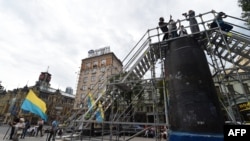KYIV -- Andriy Turchenko was a boy of seven or eight when his father brought him to the statue of Vladimir Lenin on Kyiv's Taras Shevchenko Boulevard in the 1990s, a few years after the Soviet collapse, to teach him about the Bolshevik leader's legacy.
"He was feeling nostalgic," Turchenko recalls.
This week, Turchenko returned with his own son, 5-year-old Oleksandr, for an updated history lesson -- and a selfie on the spot where Lenin long stood. The statue is gone, pulled down by protesters during Ukraine's Euromaidan revolution in 2013, and the plinth it occupied for 67 years is empty.
But thanks to a temporary art installation that put a staircase in place to allow people to ascend to the pedestal, Ukrainians are getting a chance to stand in Lenin's shoes, so to speak.
"I told Sasha," Turchenko says, using a diminutive of his son's name, "Lenin's absence means Ukraine is free."
They snapped a photo of themselves to celebrate that freedom.
Titled Inhabiting Shadows, the exhibit by Mexican artist Cynthia Gutierrez "intends to provoke a discussion and reflection about imposed memory, system failure, emptiness, identity, and occupying space," according to the artist's description.
Organized by the Izolyatsia Center for Cultural Initiatives, an art collective that relocated from war-torn Donetsk to Kyiv after fighting broke out in 2014, Inhabiting Shadows will remain in place through the end of the week. It is part of a larger exhibition called Social Contract, which aims to spur discussion about public symbols. It is on display at the Izolyatsia Center in Kyiv through August 24.
Antigovernment and pro-European protesters dragged down the Lenin monument and smashed it to pieces with sledgehammers on December 8, 2013, during the Maidan protests that drove a Russian-allied president from power the following February. For many Ukrainians, Lenin's fall was a symbol of Kyiv's rejection of Moscow's long-standing influence over Ukraine and affirmation of its citizens' right to self-determination.
It set in motion what would come to be known as the "Leninopad," or "Felling of the Lenins." At least 1,221 Lenin monuments around Ukraine have since been demolished, according to Leninstatues.ru, which tracks their removal.
The demolition of Lenin monuments is a microcosm of Ukraine's controversial policy of "decommunization" -- a post-Maidan effort to break free from the country's Soviet past. It includes renaming dozens of cities, squares, and roads, and removing communist symbols, like the hammer and sickle, from buildings and landmarks.
Not everyone is happy about that. Many in eastern Ukraine, which has historically had close ties to Russia, and particularly pensioners with fond memories of the Soviet Union, have expressed worry that their past is being erased. Some critics have pointed to the fact that decommunization, in many cases, is occurring without public discourse, leading them to accuse the government of using methods reminiscent of the very communist practices they have denounced.
Kateryna Filyuk, the guest curator behind Inhabiting Shadows and Social Contract, tells RFE/RL that the idea behind the Lenin plinth exhibition was to create something that would contribute to the public dialogue about decommunization.
Of the 21 proposals received from artists around the world, she and an international jury selected Gutierrez's, because "her suggestion was not to put something instead of Lenin, but rather to create a platform for the people of Ukraine to express their views and rethink their past and get rid of some specters of the past."
Goodbye, Lenin
Public reaction to Inhabiting Shadows has been mostly positive, Filyuk says. She recalls one older woman who remembered taking her oath as a member of the Pioneers -- a Communist Party youth group -- in front of the monument over 60 years ago. The woman told her that standing there today "was a nice way to say goodbye" to the former Soviet leader.
But some have complained that the exhibit doesn't fit in with its surroundings. "Aesthetically, it doesn't look nice," Filyuk says. "But that's absolutely not the point."
While tearing Lenin down took minutes -- and a winch -- replacing Lenin has become a contentious issue that remains unresolved. More than two years later, there has been no public consensus about what should occupy the plinth.
It was briefly occupied by a golden toilet in February 2014, a nod to rumors that Viktor Yanukovych, the former president who fled Kyiv the same month, had installed one at his gauche riverside estate outside the capital.
Earlier in July, before Gutierrez's steps went up, someone topped the column with a small statue of the Virgin Mary. But like Lenin, it also came crashing down.
The urban planning and culture departments in the Kyiv city government have struggled to come up with something permanent that would please everyone.
"If there were a hero recognized by all parts of Ukrainian society, I think his figure would be standing there already," says Filyuk, who sees no point in rushing to fill the space.
"It should remain empty. It's already a strong symbol -- an empty pedestal," she adds.
Andriy Turchenko, the father who took a selfie with his son, suggests using the pedestal for rotating exhibits. "So it can be changed as we change," he says.













